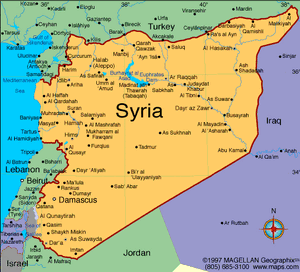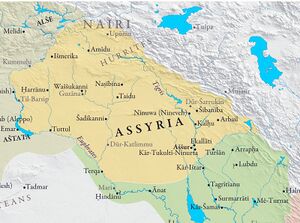Karyatayn
| Author: Laxman Burdak, IFS (R). |


Karyatayn or Al-Qaryatayn is a town in central Syria, administratively part of the Homs Governorate located southeast of Homs. Pliny has mentioned it as Cariati.[1]Its inhabitants are predominantly Sunni Muslims and Christians.[2]
Variants
- Arabic: ٱلْقَرْيَتَين,
- Syriac: ܩܪܝܬܝܢ[3]
- also spelled Karyatayn
- Qaratin
- Cariatein
- Cariatain
- Cariati (Pliny.vi.32)
Jat Gotras Namesake
- Karia = Cariati (Pliny.vi.32)
Location
It is situated on an oasis in the Syrian Desert. Nearby localities include Tadmur (Palmyra) to the northeast, Furqlus to the north, al-Riqama and Dardaghan to the northwest, Mahin, Huwwarin and Sadad to the west, Qarah, Deir Atiyah and al-Nabk to the southwest and Jayrud to the south. Al-Qaryatayn translates as "the two villages".
Antiquity
There are numerous Greco-Roman-era buildings located in al-Qaryatayn, including an extensive sanitarium known as Hamaam Balkis ("Bath of Sheba"). During Roman rule, it served as a popular health resort,[4] and a base for the legionary cavalry unit "Equites Promoti Indigenae".[5] There are also a number of Corinthian columns and marble ornaments that date from this era, when nearby Palmyra was a major city in the region;[6] Palmyrene inscriptions were found in the city written by Palmyrene residents and dedicated to the "Great God of Nazala".[7] Prior to Islamic rule in the 7th century CE, the Ghassanids had a military installation in the town.[8]
Mention by Pliny
Pliny[9] mentions Arabia....Next come the Hemnatæ, the Aualitæ, the towns of Domata and Hegra, the Tamudæi49, with the town of Badanatha, the Carrei, with the town of Cariati50, the Achoali, with the town of Foth, and the Minæi, who derive their origin, it is supposed,51 from Minos, king of Crete, and of whom the Carmæi are a tribe.
9 Their district is still called Thamud, according to Ansart.
50 Still called Cariatain, according to Ansart.
51 A ridiculous fancy, probably founded solely on the similarity of the name.
References
- ↑ Pliny.vi.32
- ↑ https://www.bbc.com/news/world-middle-east-33806122
- ↑ Thomas A. Carlson et al., “al-Qaryatayn — ܩܪܝܬܝܢ ” in The Syriac Gazetteer last modified June 30, 2014
- ↑ Leary, Lewis Gatson (1913). Syria: The Land of Lebanon. McBride, Nast & Company. p. 129
- ↑ Michael H. Dodgeon, Samuel N. C. Lieu (2002). The Roman Eastern Frontier and the Persian Wars AD 226-363: A Documentary History. p. 290. ISBN 9781134961139.
- ↑ Addison, p. 236.
- ↑ Andrew M. Smith II (2013). Roman Palmyra: Identity, Community, and State Formation. p. 124.
- ↑ Bosworth, Clifford Edmund (1980). The Encyclopaedia of Islam, new edition: Supplement. BRILL Archive. ISBN 90-04-06167-3. p. 117
- ↑ Natural History by Pliny Book VI/Chapter 32
Back to Jat Places in Arab

